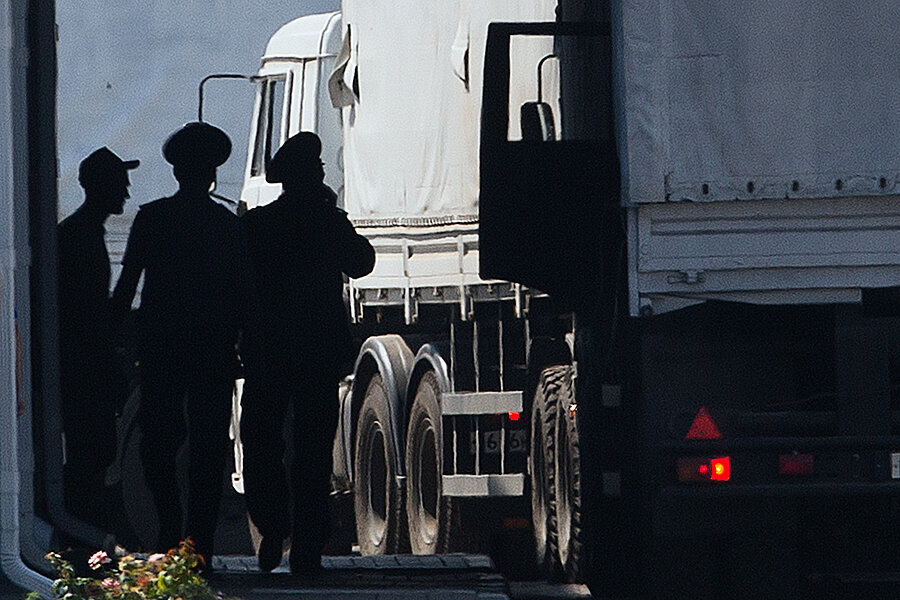Russian aid convoy crosses into Ukraine, upping diplomatic stakes
A daily roundup of reports on terrorism and security issues
Trucks from a Russian aid convoy are moving into Ukraine, after the Russian Foreign Ministry accused Kiev of obstruction and announced its convoy would no longer wait at the border for permission to enter.
“Our convoy with humanitarian aid is starting to move in the direction of Luhansk,” the Foreign Ministry said in a statement posted on its website Friday, according to Russian outlet RT.
“It’s impossible to bear this type of lawlessness, outright lies, and inability to agree. All of the pretexts for delaying the delivery of aid to the people in the region of the humanitarian catastrophe have been exhausted. The Russian side has made the decision to act,” the statement continued, according to Ria Novosti.
There was no immediate official response from the government in Kiev, which had previously warned that any unauthorized entry into Ukraine would be seen as an act of aggression. Valentyn Nalyvaychenko, the head of Ukraine's SBU security service, told the BBC that Russia's decision amounted to a "direct invasion."
The move casts further uncertainty on the situation in Ukraine, where government forces and pro-Russian rebels are fighting in the east. Western governments say Russia is supporting the rebels, which it denies. Diplomats are due to meet again on the crisis in the coming days.
The convoy of about 300 trucks had been stalled at the border since last week. Ukrainian and Russian officials were trying to negotiate a deal to allow the convoy in, the Kyiv Post explains:
Ukrainian and Russian officials have been attempting to reach a deal that would allow the convoy to be cleared by Ukrainian customs officials on the Russian side of the border before traveling through the rebel controlled checkpoint. Under the deal the [International Committee of the Red Cross] ICRC was supposed to handle the transport and distribution of the aid in rebel controlled territory.
Colonel Andriy Lysenko, the spokesman for National Security and Defense Council, said that only 34 trucks had been cleared so far. He said that most of the cleared trucks were loaded only by two-thirds.
On Friday, the ICRC announced on Twitter that the convoy was moving into Ukraine, but they were not escorting it due to security concerns.
Reporters for the Associated Press counted 34 Russian trucks crossing the border, and another 32 vehicles from the Russian side of the border passing into the customs zone.
Roughly 250,000 people have been caught in Luhansk without water or electricity for the past two weeks, and the trucks are carrying humanitarian supplies, The Christian Science Monitor reported earlier this week.
However, journalists also saw about 24 armored vehicles moving from Russia into Ukraine late last week, intended for rebel aid, the Monitor noted.
The contradictory steps are likely intended “by the Kremlin both to pressure Ukraine militarily and clear the way for Kiev politically to end the six-month old conflict with a peace acceptable to Russia,” the Monitor reports:
“Experts say the [rebel aid and humanitarian] convoys are flip sides of a single Russian strategy that aims to wear down Ukrainian forces on the battlefield; multiply the pressure on Kiev for a negotiated settlement that achieves most of Moscow's longstanding aims for Ukraine; and sate the Russian public's demand to stand up for the Ukrainian rebels.
With the limited military support sent to the rebels, the Kremlin keeps the conflict at enough of a boil to encourage Kiev to come to the table. But that's as far as Mr. Putin wants the conflict to go, [Sergei] Strokan, [foreign affairs columnist for the pro-business Moscow daily Kommersant] says, and the aid convoy to Luhansk shows Russians that he's doing something to help beleaguered Russian speakers across the border.
"Putin opened Pandora's box with this nationalist appeal, and now he's come to a red line he doesn't want to cross. Russia does not want to annex eastern Ukraine, and is ready to let it go. But the propaganda machine, once started up, has to be fed regularly. Hence, this convoy to help the people of Donbass must go forward," he adds
Russia’s decision to press ahead with the aid convoy precedes a series of scheduled meetings between heads of state. On Saturday, Germany’s Angela Merkel will visit Kiev and on Aug. 26, Ukrainian President Petro Poroshenko is due to meet Russian President Vladimir Putin on the sidelines of a European Union summit in Minsk, the Economist reports.
The Americans are only sporadically engaged by the war in Ukraine, but the European Union—led by Germany—sees it as the greatest threat to security in a generation. Mrs Merkel is making her visit to support Mr Poroshenko and his government and to sound out his readiness for talks. She will press him “to make sure they don’t cross any lines that make it more difficult to take their side,” comments Constanze Stelzenmüller of the German Marshall Fund. The meeting in Minsk may produce little more than did a recent gathering of foreign ministers in Berlin, but the mere fact that the two presidents will talk face to face for the first time since June points to the scope for dialogue.
"Diplomacy is picking up, something new is in the wind, and everyone is fighting for positions," Mr. Strokan, told the Monitor earlier this week. “Though political efforts have "sputtered along for months," he says, the rebels look to be out of options. "So, for Russia and the rebels, it's time to do a deal."
Diplomatic efforts may hit political hurdles: Both Poroshenko and Putin face stiff domestic pressure not to yield to the other side.







